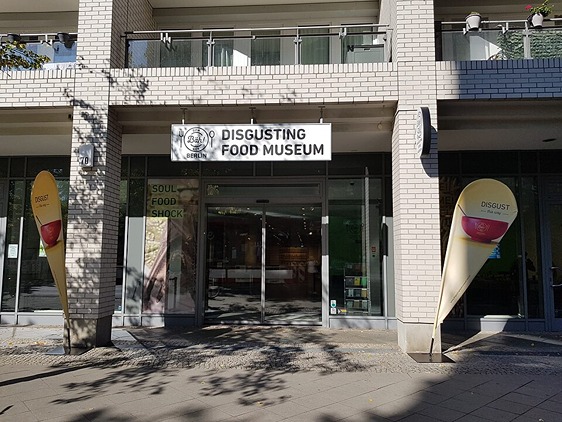Not For Sensitive Stomachs: The Disgusting Food Museum In Berlin Serves Up Culinary Torture Porn
When we think of extraordinary food, we usually imagine elaborate dishes with rich flavors and mouthwatering visuals that sometimes even work with other senses. You know, foods that look like they came out of an Instagram post or were even pre-designed for it: “Food Porn,” for better or worse. However, such food is bland and boring because, on the Horror World website, what interests us are the scarier, more bizarre, and more disgusting options. More like “Torture Porn Food,” if you will.
In the heart of Berlin, a city renowned mainly for its museums and culture, you’ll find a special museum that’s changing what we know about food: the Disgusting Food Museum Berlin, which serves as more than just a place to display disgusting foods from around the world. This museum explores the human sense of disgust, showcasing how it manifests in certain foods and allowing visitors to experience and appreciate some of these culinary masterpieces through smell and taste.
Should you add it to the list of scary attractions in Berlin, or at least include it in its extensive list of recommended museums? You are welcome to read and make your own decision.
It All Started In Sweden
The Disgusting Food Museum, located in Berlin’s Mitte district, opened in 2021. The exhibition’s actual planning began a few years ago with Andreas Ahrens, the director and co-founder of the Disgusting Food Museum in Malmö, Sweden, which we will discuss later.
The original Disgusting Food Museum opened in 2018 and was the first to introduce the concept to the general public. Samuel West curated the original exhibition, and Martin A. Völker, a German writer, cultural scientist, and aesthetician, continued its development.
The Berlin museum opened on May 28, 2021. Since then, it has displayed foods and dishes worldwide that may cause disgust. In 2018-2019, a display of disgusting food from the same chain also came to Los Angeles, and we may hear about more locations in the future.
What Is The Disgusting Food Museum In Berlin?
So, why did Samuel West and other professionals create the disgusting food museum? The main goal of the Disgusting Food Museum is to let visitors know everything they need to know about the human feeling of disgust, a feeling we know primarily from fanatic horror films. The focus here is not on horrifying scenes from extreme horror films like “The Human Centipede,” “A Serbian Film,” “Terrifier” films, or other films that star in lists of this kind, but on food and dishes from different parts of the world and from various periods that can arouse a feeling of disgust in those who are exposed to them, and of course, who eat them.
The assumption here, as described on the museum’s website, is that “disgust is human,” and even more than that: “disgust is fun.” This is an excellent reason for us, horror fans, to feel good about all the gore-laden films that no one else understands why we watch and enjoy, but that’s a story for another article.
Disgust in the case of food can be related to the appearance, texture, smell, or taste of the food, and in many cases, to several senses operating at full power here, and not for the right reasons. Note that part of the issue here is cultural because, in many cases, these are very legitimate foods in different countries. This food may be considered delicacies or at least routine or essential foods in the eyes of the local population on one hand, but on the other hand, it serves as a potential basis for a disgusting food challenge on programs like “The Amazing Race” or “Survivor” for most visitors.

In other words, the museum also explores the connection between culture and food in various regions, illustrating how culture can influence our taste and perceptions of what we eat. It raises questions that you may have already touched on in a specific context without fully understanding the answer, such as why we find certain foods repulsive while others love them, what the roles of smell and texture in our perception of taste, and what the role of culture is in all this. The museum also shows that the feeling of disgust can, to some extent, connect cultures and people.
The Disgusting Food Museum in Berlin is not just a slightly unusual tourist attraction, but an educational platform that encourages discussion on essential topics, including the acceptance of differences, the treatment of animals, cultural openness, and sustainability in food and nature. By challenging perceptions we take for granted about food, the museum encourages visitors to rethink their eating habits and be more open to new possibilities.
What Disgusting Foods Can You Find Here?
The museum’s permanent exhibition spans approximately 600 square meters and features over 90 foods, dishes, and samples from around the world. The division is primarily based on geographical region, accompanied by explanations (verbal or audio) that describe the history, culture, and uniqueness of each dish.
The Disgusting Food Museum list of foods includes:
- Casu Marzu (“Rotten Cheese”) is a traditional Sardinian cheese that is considered one of the most dangerous cheeses in the world due to its inclusion of live maggots. The production of cheese is based on its rotting in the sun, which attracts flies to lay eggs on it. The maggots are responsible for the strong and unique taste of Casu Marzu cheese, and the fact that it is considered illegal and prohibited for export and import in various countries worldwide.
- Cow blood
- Tarantula spiders and other arthropods
- Insects, such as locusts – These migratory insects are not only harmful to agriculture and were part of the Ten Commandments from the Bible, but are also a sought-after food in various countries worldwide.
- Internal organs of animals, such as parts of the face and organs that we usually avoid eating. For example, a bull’s penis that probably won’t star in your next barbecue
- Surströmming is a fermented and salted fish from Sweden that emits a strong odor; the literal translation of its Swedish name is “sour herring.” A Japanese study showed that the smell of a can of surströmming fish, when opened, is almost the same as that of a rotting corpse. This is perhaps why one of the special tasting events held at the museum throughout the year includes the opening of a can of surströmming
- Durian is a common Asian fruit found in Thailand, among other places. Durian offers the not-so-enticing combination of a problematic texture (reminiscent of custard) and a unique, fetid odor, defining it as “the world’s stinkiest fruit.” There are places in Asia where it is strictly forbidden to bring durian into public places, buses, and so on
The exhibition features live, dried, preserved, or jarred specimens, which can sometimes contribute to a sense of disgust.
Who Can Visit The Disgusting Food Museum In Berlin?
The Berlin Disgusting Food Museum is not the most popular attraction in Berlin. Even if you want to explore museums in Berlin, there are very likely many more well-known museums. It is sufficient to mention names like the Pergamon Museum, the Buda Castle History Museum, the Natural History Museum, the German Historical Museum, and the Jewish Museum in Berlin, which expose us to the less pleasant sides of the city.
The museum is especially suitable for people who belong to the following groups:
- People who love special attractions bordering on horror
- Adventurous food lovers who want to expand their culinary horizons
- Tourists looking for a unique experience that is different from traditional museums in Berlin
- People interested in cultural anthropology and global eating habits
- Groups of friends looking for challenging and unconventional ways to visit Berlin joyfully. Pictures with disgusted looks or expressions that resemble vomiting are an integral part of the thing here
Suppose you are looking for scary locations in Berlin. In that case, you may be able to add the Disgusting Food Museum to your visit plan, along with other attractions, some of which we have already reviewed on the site: the Berlin Dungeon, underground tours in Berlin, ghost tours or horror stories of Berlin or scary abandoned places in the vicinity of Berlin, from the amusement park Spreepark to the abandoned Beelitz-Heilstätten hospital, which is also known as the place that treated Hitler.
Please note that visiting the Disgusting Food Museum may be challenging for individuals with sensitive stomachs or those who are sensitive to strong odors. The museum is not recommended for very young children, although it can be interesting and even have added educational value from a certain age.
Some Food Is Too Scary To Taste
One of the highlights of food museums around the world – think of chocolate or ice cream museums, for example – is allowing visitors to learn all about their favorite food and also try it at the end of the visit, sometimes with an interesting twist (for example, unusual ice cream flavors, as we learned in the article about the scary sides of ice cream).
In the case of the Disgusting Food Museum, it’s unclear whether the inclusion of culinary tastings will please you. Still, that’s part of the point. Museum visitors can look at the foods, smell them, and sometimes even taste them. Special jars transmit the smells to the visitors, and at the end of the tour, guests can choose from a small selection of “disgusting” foods to try.
A visit to the Disgusting Food Museum is no ordinary tour. Upon entering, visitors are given a vomit bag as an “admission ticket” – an item that often becomes a popular souvenir.
Visiting The Disgusting Food Museum? Important Information You Should Know
Prices And Ticket Types
You can purchase tickets for the Disgusting Food Museum in Berlin in advance through major websites such as GetYourGuide and Tiqets, which offer convenient and quick purchase options with free cancellation up to 24 hours before the visit. The cancellation policy is a valuable advantage for those who prefer flexibility in planning their trip or dealing with delays and schedule changes, which are becoming increasingly common in our unstable reality.
Booking in advance is recommended, as it can sometimes result in lower prices. The truth is that prices at the box office, paid on the spot, tend to be more expensive and may increase as the visit date approaches. When booking, you will define your exact visit time, but the major sites offer the option of changes, with the understanding that flexibility is a key need for a trip.
The price range for the Disgusting Food Museum in Berlin, as of 2025, is:
🎫 Regular ticket (age 18 and up): 10-17 euros
🎫 Discounted ticket (7-12 euros) – reduced admission is available for children aged 6-18, individuals with physical disabilities, students, and other eligible groups. Some discounts require the presentation of an appropriate document. If you buy a discounted ticket in advance but do not present the proper document at the box office or at the time of purchase, they may charge you an additional fee at the entrance
🎫 Children up to the age of 5 enter free of charge. Of course, the responsibility, in this case, lies with the parents, both in terms of the children’s exposure to the exhibits (which may scare some of them with their appearance or smells) and in terms of the possible disruption of “too” young children to the other museum’s visitors
By the way, the physical entrance ticket is designed to resemble a vomit bag, which fits perfectly with the atmosphere and can make a great souvenir from your time here.
All payments at the museum are made by credit card or through a secure online payment system. The museum is cashless, meaning it is not the place to spend the cash you brought to Germany.
Opening Hours
As of today, the Disgusting Food Museum in Berlin is open to the public from Friday to Tuesday, from 12:00 to 18:00. The last admission to the museum is at 17:00. We recommend checking the opening hours before your visit to avoid any unpleasant surprises.
How Much Time Should You Spend In The Museum?
The museum is not huge, and you can usually finish the visit here in 1-1.5 hours. The museum doesn’t offer guided tours. Still, you can get a 70-minute audio guide in advance, available in various languages, including English, to enhance your experience here. You can download the guide here.
Where Is The Disgusting Food Museum Located?
The Disgusting Food Museum is located at Schützenstraße 70, 10117, next to Checkpoint Plaza, in the heart of the touristy Mitte district. About 200 meters away, you will find Checkpoint Charlie, the main crossing point between Berlin’s west and east sides, before the walls fell.
Getting to the area is relatively easy with Berlin’s excellent public transport, including:
Underground (U-Bahn) – line U2 to Mohrenstraße (Berlin), or line U6 to Stadtmitte or Kochstraße (Checkpoint Charlie) stations
Buses – lines 200, 265, and M29 stop a short walk away
Of course, you can also reach the museum on foot, within reasonable walking distance of some of Berlin’s must-see sights. The distance between the museum and the Brandenburg Gate, the city’s undisputed symbol, is approximately 1.5 kilometers.
Some of the links on this site are affiliate links. That means if you purchase through them, we might earn a small commission. But don’t worry... it won’t cost you extra, and it probably won’t summon anything...
So if you’re thinking of buying something… don’t be afraid to click! 🔪👁️




